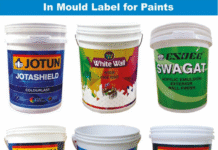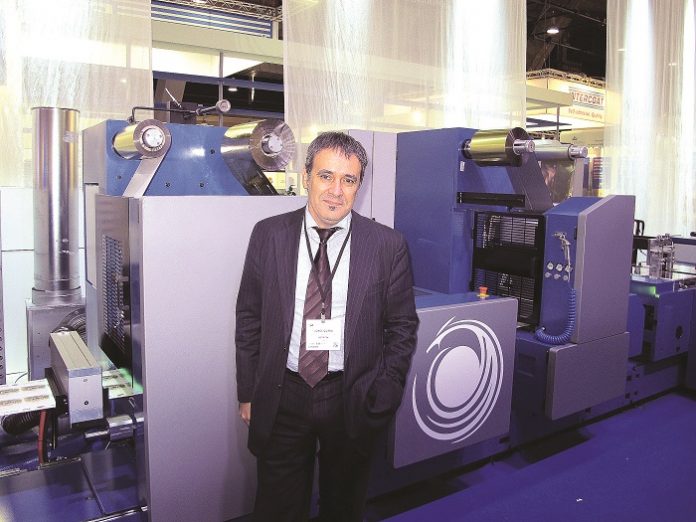
Digital printing may have captured the headlines from Labelexpo but there were plenty of new flexo solutions on show.
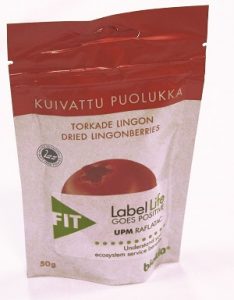
laminate for food packaging. Photo PSA
Labelexpo is a useful reminder that there is continuing innovation in the label sector. Despite the sudden interest in digital technology, narrow web flexo presses remain the workhorses, with most vendors finding ways to enhance their line-up and many actively looking to include digital print units.
Multitec demonstrated its EcoflexoVSi flexo press. This is an 8-color UV machine equipped with servo drives and chillrollers. Company director Amit Ahuja says that Multitec is also working to incorporate inkjet printheads to this press but is still assessing which companies have the necessary support infrastructure for the Indian market. He commented, “Customers are asking for digital but as a complement to their existing presses, not as a replacement. Because when you have runs of 100,000 then you also have runs of 1,000 so we need a good digital option.”
The British developer Focus Label Machinery showed off the latest addition to its eFlex range, which now gains a digital module for adding variable data. The eFlex uses a twin-servo system for fast set-up times. Focus also showed off recent enhancements to its Proflex SE flexo press. This now gains a touch screen operator panel, with the ability to archive jobs for future reference and servo-assisted controls. It’s available in 250 mm and 330 mm widths.
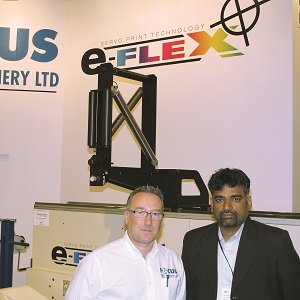
Monotech Systems India. Photo PSA
Monotech, which has recently been appointed the Indian distributor for Focus Label Machinery, also discussed its upcoming inkjet printer, the Jetsci CLP600. The marketing manager of Monotech, Akash Kumar, says that the printer will handle a wide range of substrates from 100 to 400 mm wide. It will use LED UVcuring though Monotech has yet to confirm which printheads it will use.
Gallus has updated its 10-year-old RCS430 press, which now boasts of a modern control platform that will be able to act as a standardized technology platform for a range of machine systems. It also gains a new UV-drying solution for varnishing. Meanwhile the ECS340, which is designed around a very short web path, gains a new matrix stripper and a new UV flexographic printing unit, both of which should increase its productivity. Gallus also showed the new Screeny A-Line – a robust press that allows plates to be re-used multiple times.
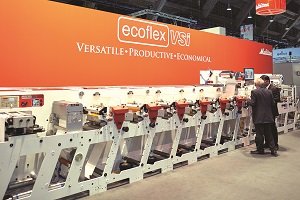
In addition, Gallus showed a new self-adhesive Twinlock sleeve that’s suitable for high speeds. It has a permanently self-adhesive polymer that is connected to a high quality polyurethane foam that is compressible to counter the effects of ghosting. MPS showed off a new version of its EF Neo flexo press, which is now servo-driven with improved web tension control systems. The EF Neo also gained a large operator control panel and a touchscreen, with overall improvements to the software. The same drive system is also used on the hybrid Symjet, which uses a Domino N610i inkjet module for imaging.
Plates and processors

waste. Photos Nessan Cleary
Fujifilm demonstrated its Flenex FW plates for narrow web flexo, part of a bigger push from Fujifilm into the flexo market, which makes sense given that Fujifilm’s Speciality Ink Systems, formerly known asSericol, is amajor supplier of UVinks for narrow format flexo. These plates have been available in the US for the last 18 months but Fujifilm is now keen to expand their use into other areas. The Flenex FW plates use a rubber-based compound that limits the plate’s exposure to oxygen to reduce the dot gain. This gives a sharper dot shape and should mean that more ink is actually transferred to the substrate. These plates are water washable, with Fujifilm demonstrating the ease of processing on the stand at Labelexpo.

There were several other notable plate processes on show. Asahi Photoproducts launched a new flexo plate processor, the AWP 4835P. It takes plates up to 120 x 90 cm and thickness of 1.14mmand 1.70mm.It’s been designed to reduce the amount of water that’s used, having reverse rotating and oscillating brushes to ensure optimum wash out performance and a two-way filtration system to capture washed photopolymer residues. David Galton, sales director for Asahi Photoproducts, added, “It is engineered to deliver a sustainable quality output with fast plate access time.”
ThermoFlexX launched a new digital plate imager, the ThermoFlexX 48, which takes plates up to 900 x 1,200 mm. It’s essentially a smaller version of the existing ThermoFlexX 60 and 80 models and offers the same resolutions from 2,400 dpi to 5,080 dpi. It has a FlexTray unit fixed to the top of the unit so that a second plate can be loaded while the first is imaging. This first plate can then be fed into an external LED exposure unit, while the second plate is automatically loaded into the imaging unit. It’s a neat idea that greatly speeds up the overall plate productivity.
Substrates
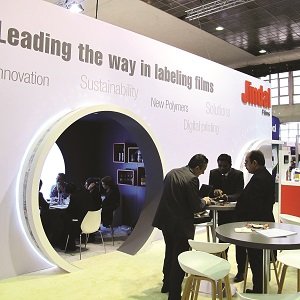
Naturally, there were a number of new labelstocks demonstrated at the show. Avery Dennison has developed a new uncoated labelstock for wine labels, called Aqua Opaque. It’s designed to withstand moisture and keep the same color appearance for up to two hours. There’s no need for an additional film layer or thicker paper, and it uses an emulsion adhesive so that it can be converted with existing equipment.
UPM showed off its Vanish range of ultra-thin clear PET label faces that promise the ‘no-label-look.’ They are targeted at food labelling on rigid plastic and glass packaging but could also offer an alternative to screen printing on bottles and cans, with effects such as fluctuating opacity, raised textures, scents, and glow-in-the dark or UV fluorescent print. UPM was keen to point out that since these labels are very thin they use less raw materials, which should make them both more economical and more sustainable.
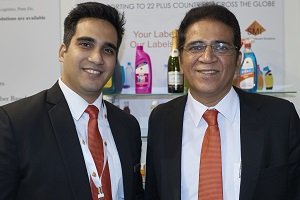
Photo PSA
The Japanese company Lintec released a number of new label stocks, including one made out of recycled PET resinfilm. There was also a substrate that used anadhesive that’s resistant to oil, and another with a transparent PET surface coating that’s resistant to oil and water and can be used to overcoat other stocks.
SMI used the show to highlightits filmic labelstocks and liners. The managing director of SMI, Ajay Mehta, says that there will always be room in the market for quality products, noting that for many customers having a reliable source of supply is more important than price. The company demonstrated its specification sheets, which aim to help users understand the different properties of each stock and to choose the right one. Mehta explains that it’s important to educate people to help them find the right stock, adding, “The labelstock business is like a blind date. We don’t know what the printing is or where the stock is going to be applied.”
Indeed, shows like Labelexpo are all about educating people as to the changing trends in the industry and newer options that are available. In this respect, despite the emphasis on the newer digital solutions, the show highlighted continuing innovation in conventional labelling, with more efficient presses and plate processors as well as expanding labelstock applications.
Rotatek
 At Labelexpo we met Rotatek’s vice president of international sales, Jordi Quera, who said that the company is experiencing healthy growth in 2015 over its 2014 figures. Its new logo and extended name to Rotatek Barcelona Printing Machinery now leverages its location in the commercial and industrial heart of Spain. Quera explained that the company’s security press installations in India are continuing with the fourth machine underinstallation while the fifth is under production.
At Labelexpo we met Rotatek’s vice president of international sales, Jordi Quera, who said that the company is experiencing healthy growth in 2015 over its 2014 figures. Its new logo and extended name to Rotatek Barcelona Printing Machinery now leverages its location in the commercial and industrial heart of Spain. Quera explained that the company’s security press installations in India are continuing with the fourth machine underinstallation while the fifth is under production.
At Labelexpo Brussels, Rotatek was showing its improved Brava variable cut-off mid-web offset press which now has the capability of a flatbed screening, embossing and diecutting stations. The company also talked about its new Universal 680 packaging press with inline finishing and diecutting. The 80-employee company continues to manufacture most of its mechanical parts. Always a leading edge technology supplier, Rotatek has 18 persons in its design, electronics and software department.





